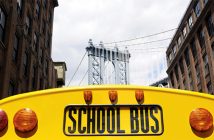
Two Brooklyn, New York public school zones have been approved by education officials to be redrawn in a way that would shift children from a mostly white and increasingly wealthy neighborhood to an essentially black and Hispanic school.
The city’s Department of Education introduced the rezoning to relieve crowding at the predominately white school and believed that it would increase diversity and enhance the ability of the department to meet the needs of students and families. The redistribution has been met with accusations of racism, gentrification, and class bias, writes Kate Taylor for The New York Times.
The current location of P.S. 8 encompasses Brooklyn Heights and Dumbo, both prosperous neighborhoods. The 2016-17 rezoning will shift Dumbo from P.S. 8′s zone to Public School 307′s in the Vinegar Hill neighborhood. Presently, P.S. 307′s zone is small and includes students from the Farragut Houses, a public-housing project.
The two schools are less than a mile apart, but 60% of P.S. 8′s students are white, and just 16% are children in families on public assistance, according to New York state statistics. At P.S. 307, 90% of the students are black or Hispanic, and approximately 90% of the families receive public assistance.
In the last few months, parents of students from Dumbo have expressed reluctance to send their children to a school with such low test scores. P.S. 307 parents, along with residents of the Farragut Houses, are concerned that the influx of wealthy students from Dumbo will result in the Education Department eventually sending children from the housing project to a different school.
These and many other concerns were expressed on Tuesday at a meeting of the Community Education Council for District 13, which is the local elected group responsible for voting on the zoning lines. The body’s decision resulted in six for the rezoning and three against the move.
Several members who voted for the move expressed it had been a difficult decision, and others were upset with those who opposed the new plan and believed there had been too much stubbornness and fear on both sides of the discussion.
State test scores for students at P.S. 307 showed that the students there were struggling. Twelve percent of students passed the English portion of the exam, and 20% passed the math portion.
But Sophia Hollander of The Wall Street Journal reported that the new principal at P.S. 307 has begun a spate of enrichment programs including Mandarin for early grades, a science magnet program funded by the federal government, and myriad after-school activities.
P.S. 307 has children with disabilities making up a third of the student body. Their test scores factor into the school’s overall numbers, explains the Department of Education. Vinegar Hill parents worry that the rezoning could upset this recent progress and hinder the school’s sense of community.
“When rich people come in, they have the money to force people to do what they want,” said Dolores Cheatom, who has a toddler and lives in Farragut Houses.
The new zoning plan has promised 50% of open seats to P.S. 307 students who are eligible for reduced-price lunches by the 2017-18 school year in order to preserve the school community.
Samuel Lieberman, reporting for New York Magazine, references a recent episode of public radio’s This American Life entitled “The Problem We All Live With” concerning school desegregation. In it, Nikole Hannah-Jones said the only thing that is going to close the achievement gap between black and white students is integration.
“We all know that our school system in New York City is in a lot of ways very segregated,” Councilman Stephen Levin said. “[This] is an opportunity to say we want to leave school segregation in the past and that we want to move forward.”




